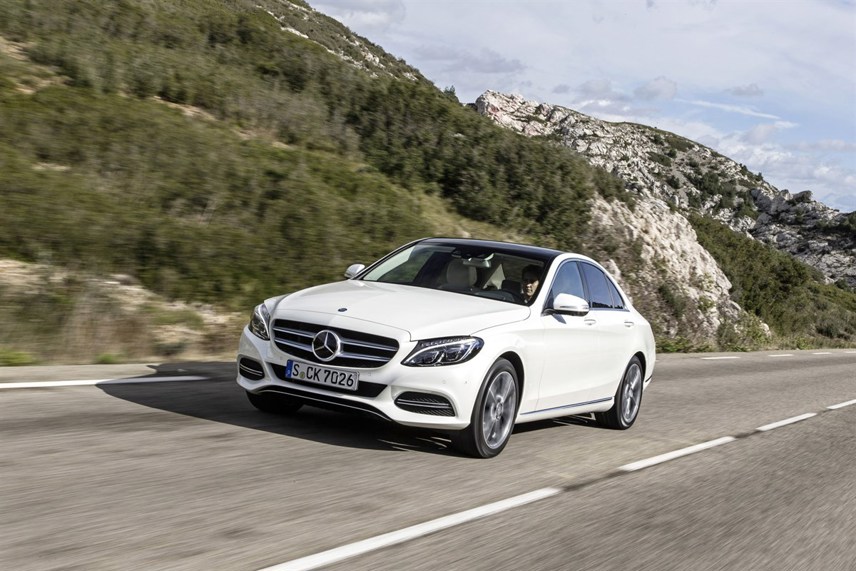Review
The quality and performance jump from C-Class to E-Class always seemed to be much greater than rivals like BMW’s 3 Series/5 Series and Audi’s A4/A6.
As a result, the C-Class always lagged behind its premium car competition. Mercedes-Benz has now closed that gap with the new C-Class, on sale in June. Packed with the latest technology and offering a responsive, yet efficient driving experience, the C-Class also closes the gap to the sector-leading 3 Series.
The question is, does it overtake the BMW? A range of diesel and petrol models will be available at launch, but of most interest to fleets will be the C220 Bluetec, a 2.1-litre 170hp diesel offering CO2 emissions of 103g/km and fuel economy of 70.6mpg, and the C250 Bluetec, which increases the C220’s power output to 204hp with 109g/km and 65.7mpg.
P11D pricing is currently available only for the C220 (C250 details will be released later this month). It starts at £29,310 for the six-speed manual SE, although the majority of orders will be for the smoother seven-speed automatic (it accounts for 83% of sales on the outgoing model), which starts at £30,810. Emissions for the auto gearbox rise to 109g/km, which moves it up a benefit-in-kind tax band.
Mercedes-Benz is confident that the most popular model will be the range-topping AM G Line, priced from £34,300 for the automatic. Emissions rise another band at 113g/km. Fleets are more likely to opt for the Sport trim (auto: £32,805), although its 110g/km emissions put it in the same tax bracket as the AMG.
That’s the facts and figures; what about the car itself? Both the C220 and C250 have a refined engine offering plenty of power, rapid reaction and ample mid-range torque. They are effortless to drive and, while the C250 ultimately has the edge, the lower-powered version will be more than acceptable for the majority of drivers.
Sat on the standard steel suspension, the C-Class provides a controlled ride, occasionally harsh over severely pitted roads but not uncomfortably so. Handling is excellent with well-weighted steering offering enough resistance without being tiring to drive.
Switch to the Airmatic air suspension, an £895 option on Sport and AM GLine, and the experience is elevated to a whole new level. Mercedes-Benz claims Airmatic could account for almost half of total sales; barring a residual value uplift, we expect fleets to choose the cheaper steel suspension option and save a few pounds.
Mercedes-Benz’s design team has created the most aerodynamic car in the sector. That’s important because it not only helps to reduce fuel consumption (assisted by a 100kg reduction in weight thanks to the greater use of aluminium), it also reduces wind noise which means the car is exceptionally quiet at motorway speeds.
The new C-Class is packed with the latest safety technology, much of it standard – including a reversing camera and Collision Prevention Assist Plus which applies the brakes to mitigate an accident at speeds of up to 125mph.
Upgrade to the £1,495 Driving Assistance package (available on Sport and AM G Line with automatic transmission), and you get Distronic Plus, which follows traffic flow at speeds of up to 40mph with no driver input, Lane-Keeping Assist, which prevents the car from drifting out of lane, and Pre-Safe brake assist.
The latter, experienced under test conditions which saw our C-Class approach a slower-moving car at 35mph, first gives an audible warning, then gently applies the brakes as an additional wake-up call. If no action is taken, the brakes are fully applied to bring the car to a halt while, simultaneously, the seatbelts tighten to hold you in place.It works when approaching both moving and stationary objects.
In addition to the diesel/petrol options, Mercedes-Benz will launch a C300 hybrid model which combines the fourcylinder diesel engine with an electric motor to generate maximum output of 231hp. The car is not an out-and-out eco warrior; it combines performance with efficiency. Emissions are just 94g/km and fuel economy is 72.4mpg, but the 0-62mph sprint figure (not available) is likely to comfortably undercut the C250’s.
Next year, the hybrid will be joined by a plug-in version, although no details are available yet. Also to follow are an estate version in July/August and a coupé next year.
Is the C-Class the new benchmark in the premium car sector? On the majority of the fleet matrix considerations, the answer is yes (albeit qualified subject to receiving the full running costs data).
It is the most upmarket car in the sector; interior quality is superb, standard equipment levels are exceptional and, on a like-for-like basis, the P11D price is firmly in its favour. The 3 Series isn’t knocked from its perch as the ultimate driver’s car, but that is not fleets’ priority. When it comes to a solid, comfortable, safe and efficient drive, the C-Class is the winner.
Specs
| Manufacturer | Mercedes |
| Model | C Class |
| Specification | |
| Model Year | 0.00 |
| Annual VED (Road tax) | £0 |
| BIK List Price | £32,805 |
| CO2 | 110g/km |
| BIK Percentage | 18% |
| Insurance Group | N/A |
| CC | N/A |
| Fuel Type | Diesel |
| Vehicle Type | |
| Luggage capacity (Seats up) | N/A |
Running Costs
| P11D | £32,805 |
| Cost per mile | 47.46ppm |
| Residual value | £13,100 |
| Insurance group | N/A |
| Fuel Type | Diesel |
| Cost per mile | 0.00ppm |
| Fuel | 0.00ppm |
| Depreciation | 0.00ppm |
| Service maintenance and repair | 0.00ppm |
Info at a glance
-
P11D Price
£32,805
-
MPG
64.2 -
CO2 Emissions
110g/km -
BIK %
18% -
Running cost
3 Year 60k : £13,100 4 Year 80k : £10,850 -
Fuel Type
Diesel



















